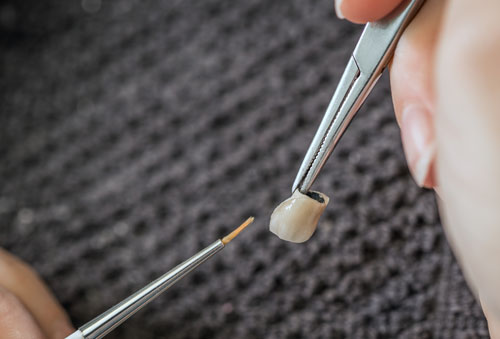Dental Bridges
You deserve a beautiful smile. Having one or more of your teeth missing can have an impact on your confidence and can keep you from laughing and smiling. This can be especially true if the space is filled with a poorly fitting denture that moves around. Whether you have lost teeth as a result of advanced decay or an injury to the tooth, it’s wise to address the gap that has been left between healthy teeth. This is typically done with the use of one or more types of dental prosthetic solutions.
There can be the inclination to ignore missing teeth if they are not the front teeth that are visible when you smile. Each missing tooth, however, can have an impact on the health of your mouth and on your bite. Also teeth either side of the missing tooth will move as will the teeth opposite.


What is a tooth bridge?
Simply put, a dental bridge will bridge the gap that was created by the missing tooth or teeth. The bridge will be fixed to the healthy teeth on either side of the gap. These teeth may need to be capped with a crown to reinforce them or can just have a ‘wing’ of bridge material on the palate or tongue facing side. If there are no healthy teeth, then a dental implant may be the direction in your dentist chooses to go to provide an anchor for your bridge.
A fixed bridge dental prosthetic will ensure good gum health is maintained while also restoring functionality to the side of the mouth.
Bridges can be made using a number of material types. These could include porcelain, Zirconia and porcelain fused to metal. The type of bridge that will work well for you will be determined based upon your unique goals for your dental health.
A bridge is fixed, that is cemented onto your own teeth or attached to implants. It is not removable and doesn’t go in a jar at night!
A bridge, or dental prosthetics, can replace a single missing tooth or several side-by-side missing teeth. A bridge can restore a confident smile and ensure that you get a comfortable and even bite.
When we are missing teeth, many of us are inclined to favour the other side for chewing. This can lead to uneven wear on those healthy teeth, which can also result in damage, decay and the potential for additional lost teeth. Spreading the force of your bite has multiple benefits for your mouth. Put simply less force is going through each individual tooth, reducing the risk of overloading them and making them last longer.
Before your prosthetic can be bonded in place, there are a few steps that your dentist will need to go through. The healthy teeth that will be used as the anchors for the bridge may require a crown so that they are durable enough to stand up to the additional pressure that they will be under when the bridge is in place.
If the teeth are badly damaged, then they may need to be extracted. Implants can then be used as supportive anchors for your bridge.
Once the above concerns have been addressed, your dentist will take impressions of your healthy teeth. This impression will be sent to the laboratory that will be responsible for milling the bridge for you.
Your dentist may opt to fit you with a temporary dental bridge until the permanent bridge is ready. Be sure that you return for the fitting of the permanent bridge in a timely manner. The temporary bridge may give you the aesthetic results that you want, but it won’t be able to withstand extended exposure to the pressure of your bite.
When the permanent bridge is ready for placement, you will return to the clinic for your dentist to bond it in place for you. If there is a temporary bridge, it will be removed. The permanent bridge will be bonded to the healthy teeth or implant, and you’ll have a great restored smile.
Patients can often restore their smile in just two visits to the clinic.
When a tooth has been extracted or has perhaps been lost as a result of an injury or decay, this can lead to a number of concerns if the gap left behind is not addressed. The primary function of a dental bridge is to restore a smile, but it will also help to boost confidence levels of a patient who may have otherwise felt reluctant to smile.
Once in place, a bridge can also help to keep your healthy teeth from shifting around in your mouth. Teeth tend to shift into any available space. This can lead to concerns with your bite alignment and can also result in decay or damage to those previously healthy teeth. Teeth that have moved around will not experience the pressure of the bite in the direction nature intended, that is straight down through the tooth. This can lead to damaging wear, gum recession and ultimately loss.
Bridges can last for a decade at least and often longer with the proper care. It’s easy to keep your bridgework clean, with routine brushing and flossing. At each of your routine checkups, your dentist will take a look at your bridgework to make sure it’s still in good shape.

What does a dental bridge cost?
If you are missing one or more teeth, you should speak to us to find out which is the best tooth-replacement option for you. We offer our patients a wide choice in dental solutions and treatments.
View our pricing chart below and learn how much you could expect to pay for a dental bridge. Book your consultation online or call our clinic to speak to a member of our staff.
| Treatment | Price |
|---|---|
| Tooth whitening | €300 |
| Crowns (dependant on type) | from €700 |
| Porcelain veneers | from €700 |
| Dental Bridges | €700 per unit |
| Inlays & Onlays | from €500 |
| Dentures - Partial acrylic (plastic) | €550 - €650 |
| Dentures - Partial cobalt (metal base) | €1400 |
| Dentures - Full upper | €550 |
| Dentures - Full upper and lower | €1200 |
| Dental Implants - Crown | €1200 (+specialist fee for surgical treatment) |
Are you ready to restore your smile with a bridge that will feel comfortable and look natural? Book your appointment online or call our clinic at 0214501306
Other Treatments
Contact Us
Other Treatments you may consider

Dental Veneers
Preventing small dental issues from flaring up into much more severe health problems is possible when you maintain a good check-up routine with our dentist. Both a check-up and consultation for additional dental services and treatments can help you to ensure proper oral health.

Dental Crowns
A dental crown is a prosthetic/artificial piece that fits over a natural tooth after it has been restored or repaired. Some people refer to crowns as caps because they fit your tooth like a cap fits your head. Therefore the remaining natural tooth is enclosed and protected from fracture. Crowns can strengthen the natural tooth while also giving you an aesthetic restoration, which can restore a smile.

Composite Bonding
Bonding consists in the application of composite resin on dental surfaces to repair decayed, chipped or misaligned teeth. Composite resin has the advantage of being aesthetic, reasonably priced and very mouldable.. It is shaped and polished according to the characteristics of the surrounding teeth.

Dentures & False Teeth
Tooth loss can lead to several concerns, including a marked impact on the ability to speak clearly, along with issues of self-esteem and confidence. The loss of one or more teeth can result in bone-regression in the jaw bone and over-closing which can, in turn, lead to the signs of premature ageing.

Dental Bridges
Simply put, a dental bridge will bridge the gap that was created by the missing tooth or teeth. The bridge will be fixed to the healthy teeth on either side of the gap. These teeth may need to be capped with a crown to reinforce them or can just have a ‘wing’ of bridge material on the palate or tongue facing side.

Dental Implants
Advances in dental care mean that more people are expected to retain their natural teeth for longer. There are, however, many who are currently missing teeth in their upper and lower jaws. Whether you have lost one or more teeth as the result of decay or injury, gaps between your otherwise healthy teeth can lead to several oral health concerns.
Frequently Asked Questions
When a tooth or teeth are missing there are three options for its replacement
- A denture
- A bridge
- A dental implant
A bridge is so called because it behaves a little like a bridge across a river. It is usually connected to the two teeth either side of a gap and holds the false tooth or teeth in the middle. Occasionally if it’s a small tooth missing then the bridge may be held by a bigger tooth only on one end which is called a cantilever bridge.
There are two types of tooth supported bridges in common use otherwise- conventional or Maryland which is also known as acid etch. Bridges may also be retained by dental implants.
Conventional bridges require the supporting teeth to be trimmed down with a little bit taken off the height and the four sides. This allows the bridgework to entirely enclose the supporting teeth. Conventional bridges can be made from a variety of materials from gold to porcelain to a mixture of metals with porcelain over the top. They can also be made from acrylic. Conventional bridges tend to be made where the biting force may be relatively high and also where the teeth either side of the space are filled already and may benefit from being covered over. As long as the supporting teeth behave themselves a conventional bridge that is well looked after should last about fifteen years.
Maryland or acid etch bridges are held in place by metal or ceramic wings on the tongue or palate side of the supporting teeth. They are much more conservative than conventional bridgework and involve less tooth structure removal. This is their main advantage and they can be performed on teeth that already have veneers on the other side. However acid etch bridges aren’t as strong as conventional and aren’t suitable in every situation or bite type. They also don’t last as long with a lifespan of 6-8 years considered the norm.
We have examples of all bridge types in our practice.
Regardless of the type of bridge the bridge should fit snugly and be aesthetic. Its shade will be matched to the neighbouring teeth. The technicians are very skilled at crafting teeth that are lustrous, lifelike and a beautiful shape. Some bridge types have some metal showing on the tongue side of the teeth.
If that’s the case an example will be shown beforehand. There should be no interference in the bite and in general one should be unaware that it’s not your own tooth. Bridges are cemented on and shouldn’t in any way feel loose.
Bridges vary a lot in type, size and material and are usually priced per unit. What this means is a bridge replacing one tooth would be three units- one either end and the false tooth makes three. An acrylic or composite bridge might be 200euro per unit but porcelain fused to precious metal maybe 800 euro per unit for conventional bridgework. All-porcelain bridgework is now the most commonly used and is 700 per unit. Maryland bridges generally cost from 1000-1200 euro.
As the false tooth is attached to the neighbouring teeth it is impossible to pass floss down in the normal way from the top of the tooth down to the gum. However, food will collect under the bridge and need to be removed. There are various tools for achieving this
- Floss threaders are almost exactly the same as the device used for passing thread through a needle. It is attached to a piece of floss and pushed gently between the supporting tooth and the false tooth. The floss is then wrapped around the supporting tooth and moved up and down. Following this then floss in gently moved under the false tooth over to the other supporting tooth and the process repeated.
- Superfloss has a rigid end and a thicker foam-like piece in the middle and is threaded through using the rigid bit until the thicker piece is in between the teeth. Otherwise, it is used in the same manner as above.
- If the space is large a small interdental brush could be used in a toothpick like action. This is however unlikely to fit under the false tooth—an area which is important to clean well.
- Various mechanical flossers now exist such as Waterpik which can be used under the false tooth gently and in between the teeth.
It should be remembered that the false tooth should be treated like a normal tooth otherwise and brushed well with a soft bristle toothbrush using the modified bass technique. Please click on the following link for a demonstration.
Occasionally a bridge may become loose and if the supporting teeth are in good condition may be recemented. If a bridge is broken perhaps one broken end can be removed and the bridge made a cantilever type hung off only one end. In general, however, it has to be said that a broken bridge usually means a bridge that is for the scrap heap.
If the tooth underneath is broken or decayed the bridge just will not fit as closely as it needs to once the tooth is repaired (if indeed it’s possible). It should be said that occasionally a fractured piece of porcelain can be repaired also. This would require careful consideration as to what caused the fracture.
Meet The Team
We have a Fantastic group of highly trained, friendly dental staff to ensure you get the best treatment in Cork.
Get in Touch with us Today
Please call or email us via the contact form and we respond to you as soon as possible.
Contact Info
Phone: (021) 450 1306 / (021) 450 1250
Email: [email protected]





